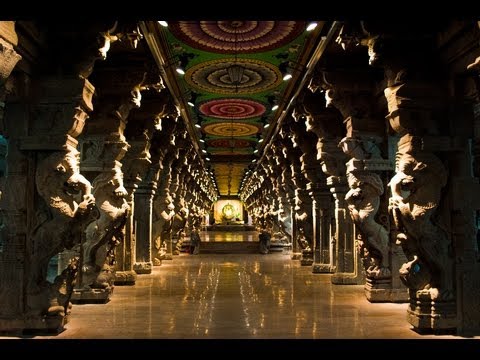Madurai Meenakshi Amman Temple
Madurai is a 2500 year old city in Tamil Nadu. Its claim to fame is the historic Meenakshi Amman Temple dedicated to goddess Parvati and her consort Shiva. Meenakshi is the incarnation of Goddess Parvati and her consort Sundareswar is the incarnation of Shiva. According to the legends, they ruled over the city of Madurai for a long time.

Towers of Meenakshi Temple: Meenakshi Temple is the finest example of Dravidian style of architecture. The temple has 14 towers of this kind.
There are numerous references to the Meenakshi Temple in Tamil literature. The temple that exists today is believed to have been built between 1623 and 1655 CE.
The Meenakshi Temple is the finest example of the Dravidian style of architecture. Tamil Nadu is the seat of Dravidian temple architecture. The state has several beautiful temples. The Meenakshi Temple has a square shape. The temple complex is spread over 45 acres and a series of streets bearing the names of Tamil months surround the temple. The temple has 14 gopurams (gateway towers). Each one measures 45 – 50 meters in height. The southern tower is the tallest. It stands at 51.9 metres (170 ft) high. There are shrines over the sanctums of the main dieties. About 15,000 devotees visit the temple every day. Fridays are special and attract even more pilgrims. The temple has about 33,000 sculptures. It is the most visited tourist attraction in Madurai. Meenakshi Tirukalyanam is a 10-day festival celebrated between April and May.
Legend
Meenakshi is an avatar of Goddess Parvati. Meenakshi means one whose eyes have the shape of fish. In temples where Shiva is worshipped, he tends to be the principal deity. Meenakshi temple is an exception to this rule because here Meenakshi (Parvati) is the main deity.

Meenakshi’s marriage to Sundareswar was solemnized by Lord Vishnu. This sculpture shows Vishnu performing the kanyadaan (the giving away of the bride).
The second Pandya king Malayadwaja Pandya and his wife Kanchanamalai were upset that they had no children. So they performed the Putra Kameshti Yaga. This is a sacrifice performed by childless couples. Upon the completion of the Yaga, a girl arose from the holy fire and she had three breasts. The king and the queen were worried about this anomaly. However, a voice from the heavens told them that the third breast would vanish when the girl meets her future husband. They named the child Tadaatagai and declared that she would be the heir to the throne. She was a brilliant child and learned all the 64 sastras (sciences).
When Tadaatagai grew up, the king decided to coronate her, but before that she had to conquer the three worlds. Tadaatagai conquered Vishnu’s Abode Vaikunta, Brahma’s Abode, Sathyaloka, and Devas’ abode Amaravati without any difficulty. She then advanced towards Kailasha where Lord Shiva resides. She defeated his army of demons (bhoot ganas) and his vehicle Nandi (the celestial bull). But she couldn’t fight Shiva. As soon as she saw him, her third breast vanished. She realized that he was her destined husband. Shiva agreed to marry her and they returned to Madurai. The king was extremely happy and married his daughter off to Shiva. The marriage was such a grand affair that the whole earth assembled at Madurai. Even gods attended the wedding. Even today, a ritual procession is held every evening before closing the temple. The image of Sundareswar (Shiva) is carried to Meenakshi’s room to consummate the union. The image will be taken back the next morning.

The Hall of 1000 pillars is one of the chief attractions at the Meenakshi Temple. This hall has two rows of pillars. Images of Yali (a beast with the head of an elephant and the body of a lion) are carved on these pillars. The 1000 pillar hall actually consists of 985 pillars.
History
According to legends, the Meenakshi Temple was built by India (king of devas). Tamil poets have been writing of this temple for the last two millennia. When Malik Kafur invaded India in 1310 AD, he reportedly plundered the temple and destroyed it. Restoration works began during the reign of the Nayak dynasty. The temple that we see today was built during the reign of Thirumalai Nayak (1623–55). Every family in Madurai has an emotional attachment to this temple because they all contributed towards its construction. The king had sought donations from the people to build the temple.
Temple tank and surrounding portico
The sacred temple tank measures 50 meter by 37 meter in size. According to Tamil legends authors used to place their works on the water of this tank. Poorly written works would sink in the water whereas superior works would float. Tiruvalluvar’s Tirukkural was one such work that floated.
The major attractions of this temple are its famed pavilions or mandapams. The most important among them are the Aaiyiram Kaal Mandapam (Hall of Thousand Pillars) and Killi Kootu Mandapam (bird cage corridor). each of these pavilions has a story of their own.